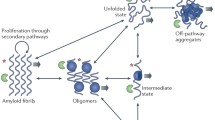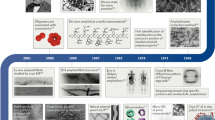Abstract.
Amyloidoses are diseases, including some currently prominent such as Alzheimer's disease, bovine spongiform encephalophaty (BSE) and Type II diabetes, in which soluble proteins are deposited in a specific, highly stable, fibrillar form. The amyloid fibrils are made up of protofilaments whose molecular structure is composed of pairs of β-sheets in a helical form that allows them to be continuously hydrogen-bonded along the length of the fibril. The observation that similar fibrils are generated from different proteins indicates that fibril formation is accompanied by structural conversion. The transmissible spongiform encephalopathies, such as BSE and kuru, involve an infectious agent identified with the prion protein. The properties of the agent are more consistent with prion amyloid than the protein itself, suggesting infectivity in these diseases is equivalent to the 'seeding' of amyloid fibrils at a new site.
Similar content being viewed by others
Author information
Authors and Affiliations
Additional information
Rights and permissions
About this article
Cite this article
Serpell, L., Sunde, M. & Blake, C. The molecular basis of amyloidosis. CMLS, Cell. mol. life sci. 53, 871–887 (1997). https://doi.org/10.1007/s000180050107
Issue Date:
DOI: https://doi.org/10.1007/s000180050107




